The SRAM mega-corp took us to Glyncorrwg Forest Park in South Wales recently to show us their latest products. In between rain, midges and drinking coffee the focus of the event was the launch of more affordable 10spd drivetrains, with X.0, X.9 and X.7 10spd flavours now available instead of the just the race focused, cost-no-issue XX group.
That wasn’t all though, as we were shown new Rock Shox fork flavours, the Vivid DH air shox and new Code brakes amongst other things.
Of great interest was also Rock Shox’s entry into the uppy-downy post market with the Reverb. We got chance to have a look and feel of the thing but not to ride it – this model was a pre-production effort and understandably SRAM is very keen to make sure this post is totally reliable by the time the public get hold of them.
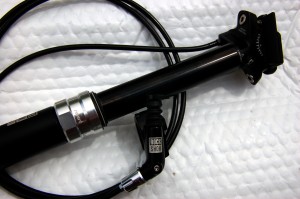
It will be available in 30.9 and 31.6mm diameters and in 360 and 440mm lengths with 125mm of stepless travel. The post uses an air valve to provide the return pressure, the remote lever is hydraulic to prevent issues with cable stretch and the return speed of the post is adjusted by twisting the end of the lever.
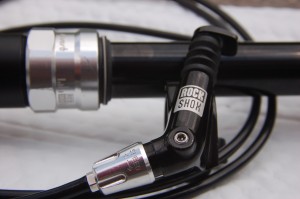
Adjustable rebound on a post may sound like gilding the lily, but it makes a lot of sense in the real world – if you prefer the post either all-up or all-down then you can run it fast to save time but if you prefer to get the height “just right” then it can be set slower so you have more time to adjust. We can’t wait to have one for test – if this delivers the goods then the days of the unreliable or rickety adjustable seatposts out there should be numbered.
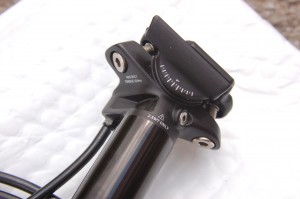
On to X.0 now, which has become a full groupset with the the old Elixir CR Mag level brake now redesigned and rebranded as an X.0 product. The new lever uses the same Taperbore technology to balance power and modulation but it has been redesigned to be far more tolerant of air in the system – SRAM engineers have realised that in the real world it’s hard to remove every last bit and so they have designed around it. The carbon lever blade has also had a redesign and feels much stiffer and nicer.
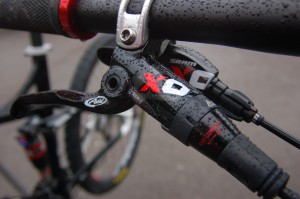
The calliper is more heavily sculpted and is made not from magnesium but aluminium – magnesium is great for light weight but the X.0 brake is designed to be used on trail bikes and freeride machines and it needs to cope with much more heat than a magnesium calliper could take.
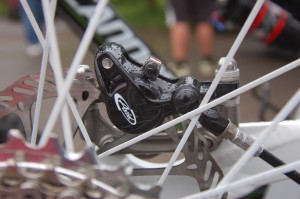
SRAM are very keen to promote a 2×10 drivetrain as the ideal choice for trail riding and pretty much all styles of riding, rather than purely as an XC racer’s setup. There is a good logic behind it – there’s less duplication of ratios and unless you’re into doing Alpine tours on a heavily laden bike the 22-34 granny gear is one used when you are close to getting off and pushing, nevermind the 22-36 ratio that SRAM 30spd would provide.
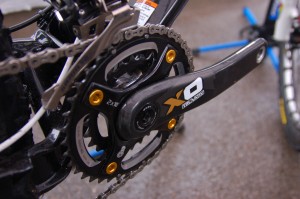
From the brief test around the trailcentric windy, rocky singletrack of Afan, it makes sense – the extremes of ratio are not missed and strangely it gets you to stay on top of a harder gear when climbing, forcing you to make faster progress. Of course it will be a personal choice that will largely come down to where you ride – flatter places and most trailcentres will be fine on 2×10, folk in bigger mountains may want the extra ratios of 3×10.
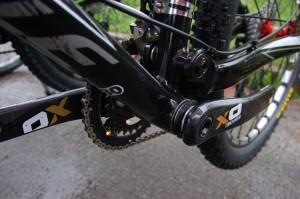
A 10spd drivetrain requires much more careful setup than 9spd but I didn’t encouter any skipping gears during our test – it will take more than this to convince the doubters (especially those still praising 8spd or shunning gears altogether) but Dave has got on well with his XX’d up Cannondale Rush longtermer in his local mud’n’grit.
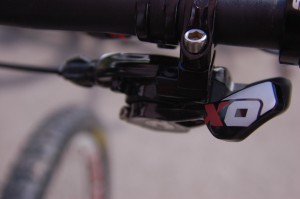
X.0 cranks will have carbon arms and come in either GXP or BB30 favours and will use with a spider to mount either two or three rings. Twin ring ratios will be your choice of 26-39 or 28-42 using a larger than normal BCD and the triple will be the classic 22-32-42 setup with a 104 BCD so your existing kit will fit should you run double and bashguard.
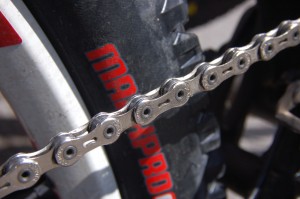
The eagle eyed or terribly geeky amongst you will notice that the chain in the shot above has outer links that are smaller than the inner links – this is done to prevent large stresses being put on the edge of the chain when shifting across sprockets and so help reduce chain breakage and extend life. Cunning.
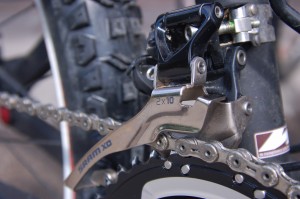
Front mechs have never featured heavily in the SRAM lineup but there is a full range for 2011, with 2 and 3 ring specific mechs available to fit all styles of mounting, including E-type.
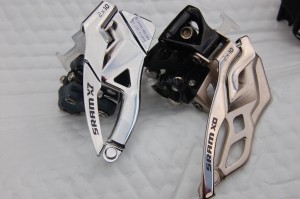
Rear mechs and shifters are going to be using the Exact Actuation technology that differs from the old 2:1 set ratio as the ratio now varies across the cassette for optimum positioning and better shifting. Rear mechs will be available in short, medium or long cage styles and are designed to have better cable routing to keep your cable housing out of trouble.
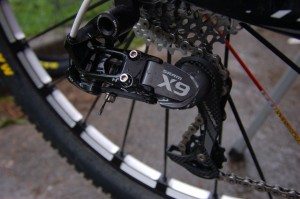
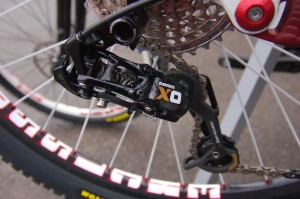
You may have noticed the range of colours X.0 comes in – there’s gold, blue, red and a more discreet grey/silver for anyone that doesn’t want to draw too much attention.
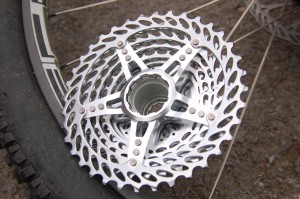
On to the world of cassettes. The top flight XX cassette is produced in an incredibly time, material and labour intensive way which just wouldn’t be viable for the more workaday groupsets, but they still manage to pack some interesting construction into the X.0, which uses a similar mud shredding open design that is made of individual rings riveted together rather than machined from a whole.
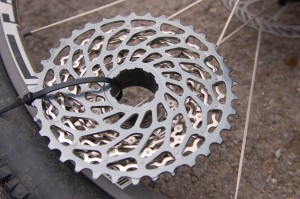
The X.7 and X.9 cassettes will use more normal alloy spiders to hold the rings together – we didn’t get to see an X.9 but the construction method is pretty much the same as the X.7 above, although with superior materials.
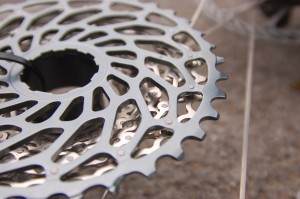
Finally we’ve got the new Avid Code. The old version was very powerful and resistant to fade on the steepest descents but that carried a penalty in terms of weight. This version has been heavily slimmed down to feel at home on DH rigs and freeride bikes. Although the pros tend to use the XX or X.9 on their downhill bikes, mere mortals are better off with the Code – unsurprisingly pro downhillers don’t tend to drag their brakes..
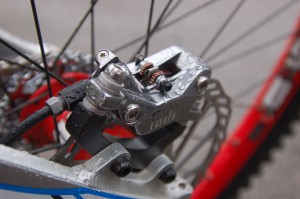
Apart from being much lighter the calliper has been designed to make pad removal and refitting much easier, which was a stalling point on the older version. You still need to remove the wheel but it shouldn’t be the battle that it used to be.
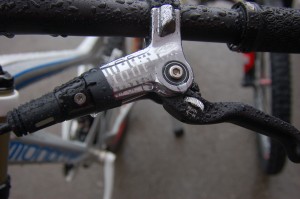
The new lever is also lighter and uses Taperbore technology which should make controlling all that power a little easier. Lever reach is also adjustable on the lever without tools and there is even a basic lever without Taperbore that saves even more weight.
The release date is mooted to be around August for all of the new gear, so expect to see out and about shortly…
Comments (13)
Leave Reply
Post Comment
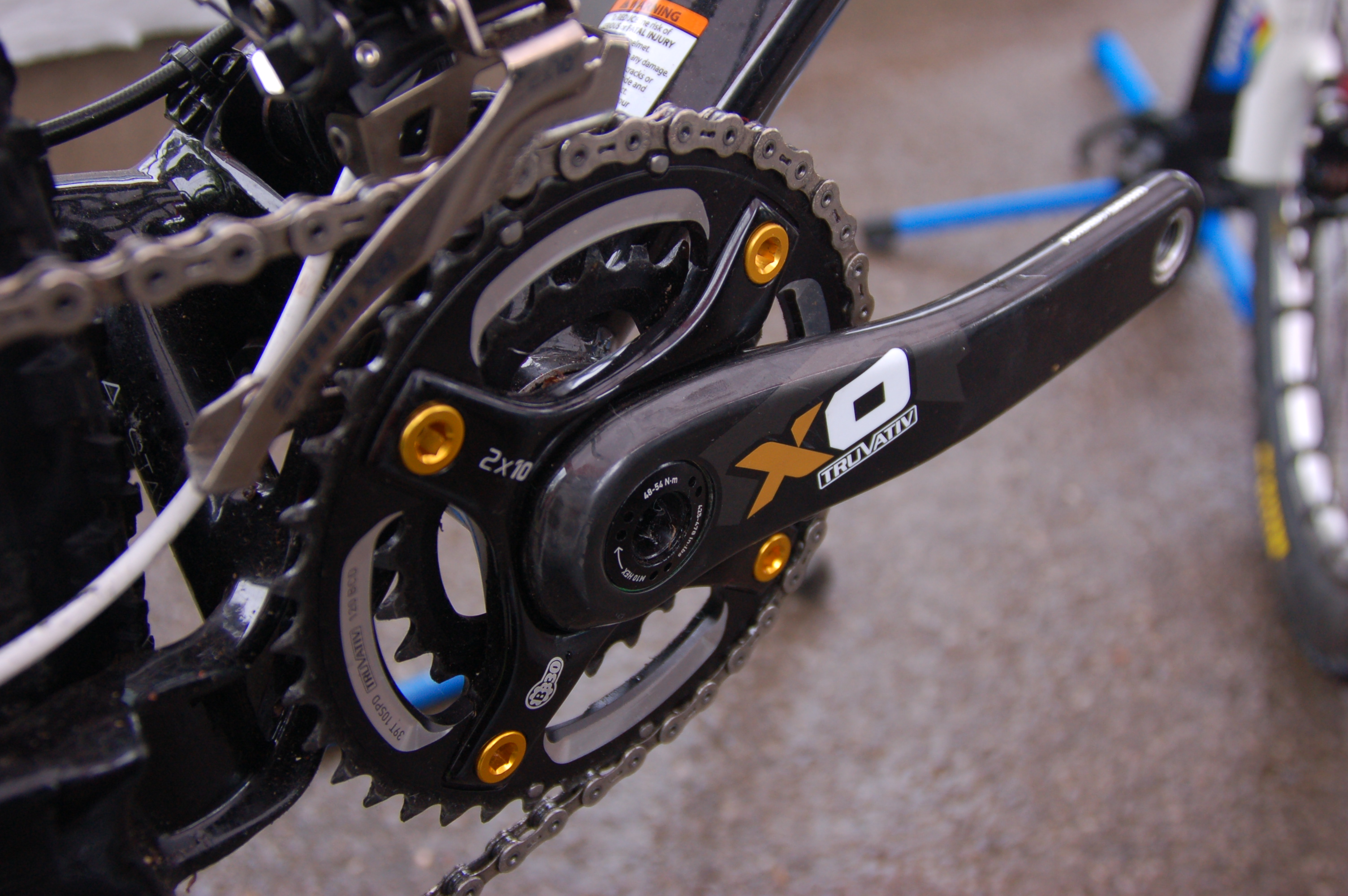
Any word on whether a 27.2mm Reverb post might be in the pipeline??
I tried not using my 22 ring for a while but it’s just gets too much effort without those bottom three ratios. I happily live without the top three ratios provided by the 44 ring though. Sure I would feel different if I was more than a weekend warrior or into racing.
I wouldn’t hold you breath for a 27.2mm version sorry…
Red X0 in perfect match for my Kona, shocker!
You know they do RS forks to match X.0 now Dave…
That’s the first uppy/downy seatpost that makes me think it might actually be worth getting. Good clamp assembly by the look of it and looks well built without being hideously ugly or cheap looking like the current crop.
that x7 cassette looks nice. I can’t tell from the photo, do the splines extend all the way through?
I don’t suppose there was any dicussion of when the Reverb will be on sale and how much it will cost?
30.6mm and 31.9mm, is this right?
Thecrackfox – I don’t know what you mean…
(thanks for pointing it out)
Any idea when the 2×10 (X9 specifically) is going to be avilable to buy in the UK?
singletrackjon – I meant they don’t seem like very common seatpost sizes, there are currently 7 bikes in my garage and of two others I have owned recently, non of them had a 30.6mm or 31.9mm seatpost, whilst 5 of the refered to 9 bikes have had 31.6mm seatpost diameters. That’s what I meant, so is it a typo or designed for specific major bike manufacturers?
In case SRAM do read this thread, if we are going to go 2 x 10 then I would mainly like a gripshift version. Otherwise I won’t want to change to it.
But, also the ability to switch to a triple chainset at the front for that occasional more extreme riding.
Then, hey presto, just wind out both grub screws on front mech and use more of the gripshift twist for the triple changing.
(Is that feasible?)
I did a race in Italy this year, and in previous ones there where I have zigzagged up the road in 22-32 or got out of the saddle in 22-34 because the roads are so steep, and this was the road sections.
Only in Italy are the roads so steep.